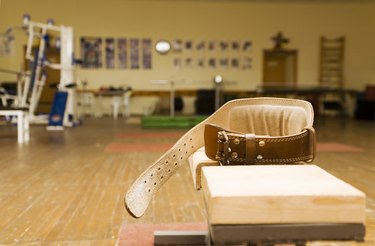
Weight belts are a staple in most gyms and fitness centers. Many gyms provide weight belts for patrons to borrow, but many people just bring their own. Weight belts are usually made of thick leather, are about four to six inches wide, and have a metal buckle to keep them secure at the waist. Do not confuse weight belts with corset-style back braces and do not use either of them as a substitute for the other.
Advantages
Video of the Day
According to the National Strength and Conditioning Association, the best reason to use a weightlifting belt is to increase intra-abdominal pressure, or pressure in your abdomen, during heavy or strenuous weight lifting. This pressure creates a rigid core, stabilizing your spine and helping increase your maximum power. This pressure also keeps your spine from collapsing under heavy weight. You can create your own intra-abdominal pressure by breathing in, holding your breath, and pushing out with your stomach muscles, a move called the Valsalva maneuver. The weight belt gives your stomach something to push against, increasing your pressure.
Video of the Day
Disadvantages
A common misconception about the weight belt is that is supports your spine during normal, moderate weight training. However, the weight belt is too narrow and rigid to provide proper spinal support in this case. If you have a previous injury or feel you need spinal support, talk to your doctor about an appropriate back brace for training. Weight belts, when used improperly, discourage the use of your own core and abdominal muscles, muscles that are necessary to build and help protect your spine. When they are used as a crutch, they can actually weaken your abdominal muscles.
Proper Use
Utilize a weight belt during heavy power lifting at or above 80 percent of your one-repetition maximum. You can also use them for spinal support during heavy squatting and deadlifts. As your strength improves, discontinue use of the belt unless you are lifting over 80 percent max. Power lifting that usually requires heavy lifting, and therefore a weight belt, includes cleans, snatches and jerks. Unsupported overhead lifts, like standing maximal shoulder presses, also warrant the use of a weight belt.
Improper Use
Do not use a weight belt for lifting that is under 80 percent of your one repetition maximum as it can discourage use of your own muscles. Do not wear a weight belt for core strengthening exercises such as planks, crunches and trunk rotations. Do not use a weight belt during any exercise where you are supine or lying on your back, sitting vertically. They are meant to be used for standing exercises only. If you have high blood pressure, Gregory Welch, Certified Athletic Trainer, advises against performing exercises that increase intra-abdominal pressure and therefore require a weight belt, as doing so could raise your blood pressure to unsafe levels.